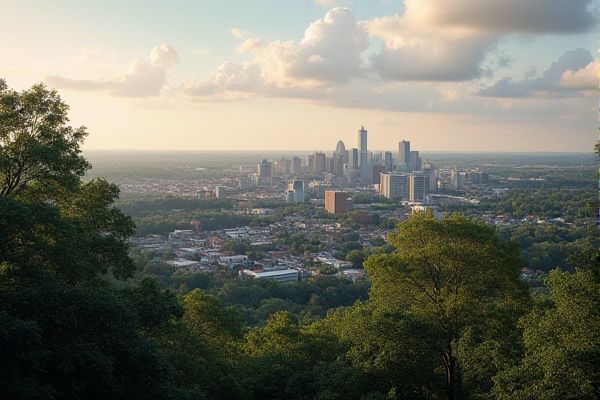
Insights from Virginia residents and expatriate communities: Weather variations between mountains and coastlines. Competitive job market, especially in tech. High cost of living in Northern Virginia. Rich cultural and historical landmarks. Excellent public school systems. Diverse dining and culinary experiences. Proximity to Washington, D.C. Strong military presence and community. Outdoor activities: hiking, fishing, beaches. Reliable public transportation options.
Weather variations between mountains and coastlines.
Virginia residents and expatriate communities experience significant weather variations between the mountains and coastlines, with the mountains having a warm-summer humid continental or oceanic climate and the coastal areas a humid subtropical climate, influenced by the moderating effects of the Atlantic Ocean and the Gulf Stream. This diversity results in differing precipitation patterns, temperature ranges, and extreme weather events such as snowfalls in the mountains and coastal storms along the tidewater region. For more comprehensive details, you can visit the Climate of Virginia page on Wikipedia.
Competitive job market, especially in tech.
In Virginia, the job market, particularly in the tech sector, remains competitive despite some softening. The state saw a decline in payroll employment and an increase in the unemployment rate to 2.8% in August, but it still boasts a higher labor force participation rate than the national average. The tech sector is expected to grow, with significant job openings projected, especially in areas like Cybersecurity, data analysis, and software development.
High cost of living in Northern Virginia.
The high cost of living in Northern Virginia is driven by a thriving job market, high-quality amenities, and a competitive housing market, requiring a single adult to have an annual pre-tax income of approximately $49,973 and a household with two working adults and one child to have around $92,875 annually to cover basic living expenses. Factors such as traffic congestion, higher tax rates, and the influence of high salaries in sectors like federal government and tech industries contribute to the elevated cost of living in the region. For more details, you can visit the Cost Of Living In Northern Virginia article to explore how these factors interplay and influence everyday life in the area.
Rich cultural and historical landmarks.
Virginia is rich in cultural and historical landmarks, with sites like Patrick Henry's Scotchtown, the John Marshall House, Historic Jamestowne, Smith's Fort, Bacon's Castle, and the Cape Henry Lighthouse, offering insights into the state's significant historical events and figures. These landmarks provide a deep dive into the state's colonial past, the American Revolution, and the lives of influential Virginians, making them essential for both residents and expatriate communities interested in Virginia's Heritage.
Excellent public school systems.
Virginia's public school system is highly regarded, ranking 9th nationally, with strengths in high school graduation rates for low-income students, preparation for AP exams, and school safety. However, there is room for improvement in reading scores and pupil-teacher ratios. For more details on this impressive ranking, you can visit the comprehensive coverage provided by Fox 5 DC, which delves into the factors contributing to these accomplishments and areas needing attention.
Diverse dining and culinary experiences.
Virginia offers a diverse and vibrant culinary scene, featuring a mix of local wines, craft beers, and spirits, along with unique dining experiences that include Pakistani-Appalachian fusion, Vietnamese cuisine, and traditional Southern cooking. These culinary delights highlight the state's heirloom grains, vegetables, and iconic oysters. For those interested in exploring more about Virginia's food and drink, the Virginia Tourism Corporation provides a comprehensive guide to the state's gastronomic offerings.
Proximity to Washington, D.C.
Living in Northern Virginia, particularly in cities like Falls Church, offers expats and residents the benefits of a quaint, welcoming community with easy accessibility to Washington, D.C., providing a balance between the tranquility of a charming locale and the advantages of being near the nation's capital. Residents in Virginia, such as those in Arlington, appreciate the proximity to Washington, D.C., known for its thriving job market, cultural experiences, and amenities like top-notch museums and a vibrant food scene, although this convenience comes with higher living costs. For more detailed insights, visit Expat Network for expert guidance on settling in these regions.
Strong military presence and community.
The Northern Virginia region, with its strong military presence, is actively working to ensure inclusivity and equity for military families through the One Military, One Community (OMOC) initiative. This effort involves quarterly meetings, community listening sessions, and addressing issues such as housing, public safety, and education to create a more inclusive environment for military members and their families.
Outdoor activities: hiking, fishing, beaches.
Virginia residents and visitors alike enjoy a wide range of outdoor activities, including hiking through state parks and forests, fishing in the Chesapeake Bay and various lakes and rivers, and relaxing on the beaches of Virginia Beach, which offers opportunities for surfing, swimming, and other coastal activities.
Reliable public transportation options.
Virginia residents and expatriate communities have access to a comprehensive network of public transportation, including Metrorail with 98 stations and 128 miles of track, Metrobus operating 24/7, and various local bus systems such as Arlington Transit, Fairfax Connector, and Alexandria Transit Company's DASH system. These services provide reliable and interconnected solutions across the Northern Virginia region. For more detailed information about the available systems, visit the Northern Virginia Transportation Commission website, which offers an extensive overview of the region’s public transit options.
